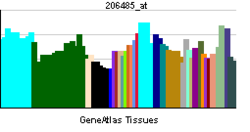CD5 (protein)
| CD5 | |||||||||||||||||
|---|---|---|---|---|---|---|---|---|---|---|---|---|---|---|---|---|---|
 |
|||||||||||||||||
|
|||||||||||||||||
| Identifiers | |||||||||||||||||
| Aliases | CD5, LEU1, T1, CD5 molecule | ||||||||||||||||
| External IDs | OMIM: 153340 MGI: 88340 HomoloGene: 7260 GeneCards: CD5 | ||||||||||||||||
|
|||||||||||||||||
| RNA expression pattern | |||||||||||||||||
 |
|||||||||||||||||
| More reference expression data | |||||||||||||||||
| Orthologs | |||||||||||||||||
| Species | Human | Mouse | |||||||||||||||
| Entrez |
|
|
|||||||||||||||
| Ensembl |
|
|
|||||||||||||||
| UniProt |
|
|
|||||||||||||||
| RefSeq (mRNA) |
|
|
|||||||||||||||
| RefSeq (protein) |
|
|
|||||||||||||||
| Location (UCSC) | Chr 11: 61.1 – 61.13 Mb | Chr 19: 10.72 – 10.74 Mb | |||||||||||||||
| PubMed search | |||||||||||||||||
CD5 is a cluster of differentiation expressed on the surface of T cells (various species) and in a subset of murine B cells known as B-1a. The expression of this receptor in human B cells has been a controversial topic and up to date there is no consensus regarding the role of this receptor as a marker of human B cells. B-1 cells have limited diversity of their B-cell receptor due to their lack of the enzyme terminal deoxynucleotidyl transferase (TdT) and are potentially self-reactive. CD5 serves to mitigate activating signals from the BCR so that the B-1 cells can only be activated by very strong stimuli (such as bacterial proteins) and not by normal tissue proteins. CD5 was used as a T-cell marker until monoclonal antibodies against CD3 were developed.
...
Wikipedia
